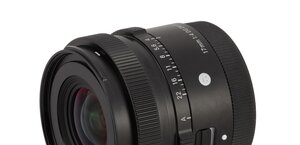Sigma A 24-35 mm f/2.0 DG HSM
4. Image resolution
Let’s check how the tested lens compares here; its results in the frame centre at 24, 28 and 35 mm presents a graph shown below.

Please Support UsIf you enjoy our reviews and articles, and you want us to continue our work please, support our website by donating through PayPal. The funds are going to be used for paying our editorial team, renting servers, and equipping our testing studio; only that way we will be able to continue providing you interesting content for free. |
- - - - - - - - - - - - - - - - - - - - - - - - - - - - - - - - - - - - - - - - - - - - - - - -
Let’s start untypically with the maximum MTFs which the lens reaches by f/4.0. They vary from 44 to 46 lpmm, depending on the focal length. If in the introduction you read that the best fixed focus devices get to 44-47 lpmm and here a zoom lens presents a similar performance there is nothing left to add I suppose. The statement that the Sigma 24-35 mm is in fact a ‘three primes in one’ instrument doesn’t sound so groundless anymore. For instance the maximum resolution value of the Canon EF 35 mm f/2 IS USM was also 46 lpmm.
What’s interesting, at the maximum relative aperture the Sigma should be only praised. The 24 mm focal length is the best with an outstanding result of over 42 lpmm. The 28 mm focal length is the weakest but it doesn’t mean it fares badly; by f/2.0 its resolution is less than 37 lpmm. At the maximum aperture the result we got by f/2.0 was less than 40 lpmm. It is actually slightly better than the result of the Canon 35 mm f/2 IS USM which was able to get to 38 lpmm. What’s more, the Sigma simply outclasses the Nikkor AF-S 28 mm f/1.8 G which, by f/2.0, barely exceeded 30 lpmm and needed to be stopped down to over f/2.8 to approach 40 lpmm.
To sum up in the frame centre the Sigma 24–35 mm is every bit as good as fixed focus lenses and we mean here both its maximum performance and how it fares at the maximum relative aperture. A round of applause!
Now let’s check the situation on the edge of the APS-C/DX sensor.
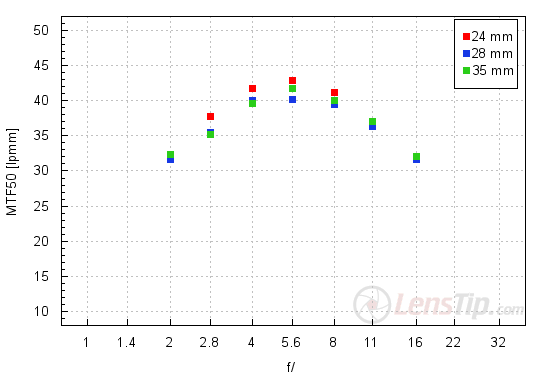
Once again you should praise the best results which, this time, can be observed near f/5.6. If a zoom lens at all focal lengths is able to exceed a level of 40 lpmm then its performance must be called excellent without any doubts. If, additionally, across the whole focal range at the maximum relative aperture the lens is able to exceed the decency level, like in the case of the Sigma tested here, there should be no reservations whatsoever. Mind you at 35 mm the MTFs of the Sigma are even a tad better than those of the fixed focal Canon 2/35 IS.
Is there any weak point on a very demanding edge of full frame? Let’s find out.
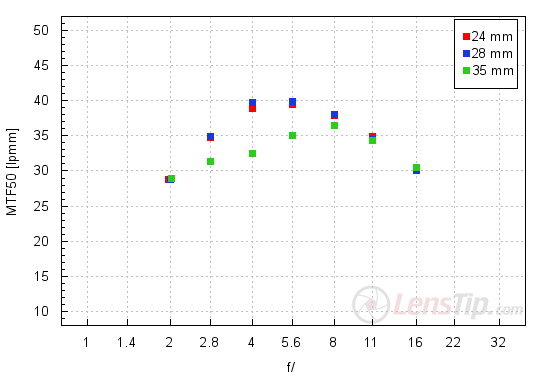
It’s easy to notice you don’t observe here nice, very even performance anymore. The 35 mm focal length fares worse than the 24-28 mm range and, at the maximum relative aperture, you land a bit below the decency level. Is that a serious reason to complain? Definitely not. The fixed focus Canon 35 mm f/2 IS USM had to be stopped down to almost f/4.0 in order to reach the same decency level. The Sigma manages to get there before f/2.8 so it fares better than that “prime”. The tested lens also compares very favourably to the Nikkors, the AF-S 1.8/28 and the 1.8/35; both of them on the edge of the full frame were useful from f/2.8 but they could get only as high as 33-34 lpmm. The Sigma, for a change, is able to brush against 40 lpmm!
The summary is surprising even for me. If you decide to buy the Sigma there will be really no necessity to own several fixed focal lenses. The rival lenses, presented not so long ago, such as the Canon EF 35 mm f/2.0 IS USM, the Nikkor AF-S 28 mm f/1.8G or the Nikkor AF-S 35 mm f/1.8 G ED can compete with the Sigma on equal terms only in some aspects, more often than not losing to it. I don’t believe my own eyes!
At the end of this chapter, traditionally, we present crops taken from our resolution testing chart photos which were saved as JPEG files.
| Canon 5D MkIII, JPEG, 24 mm, f/4.0 |
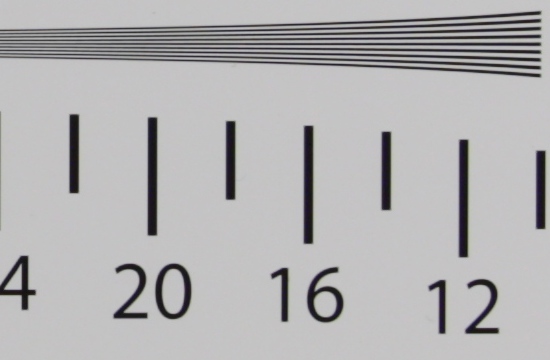 |
| Canon 5D MkIII, JPEG, 28 mm, f/2.0 |
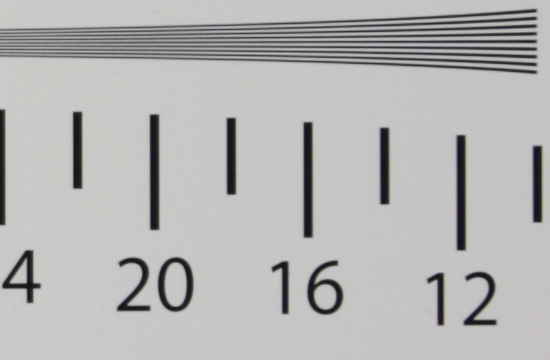 |





